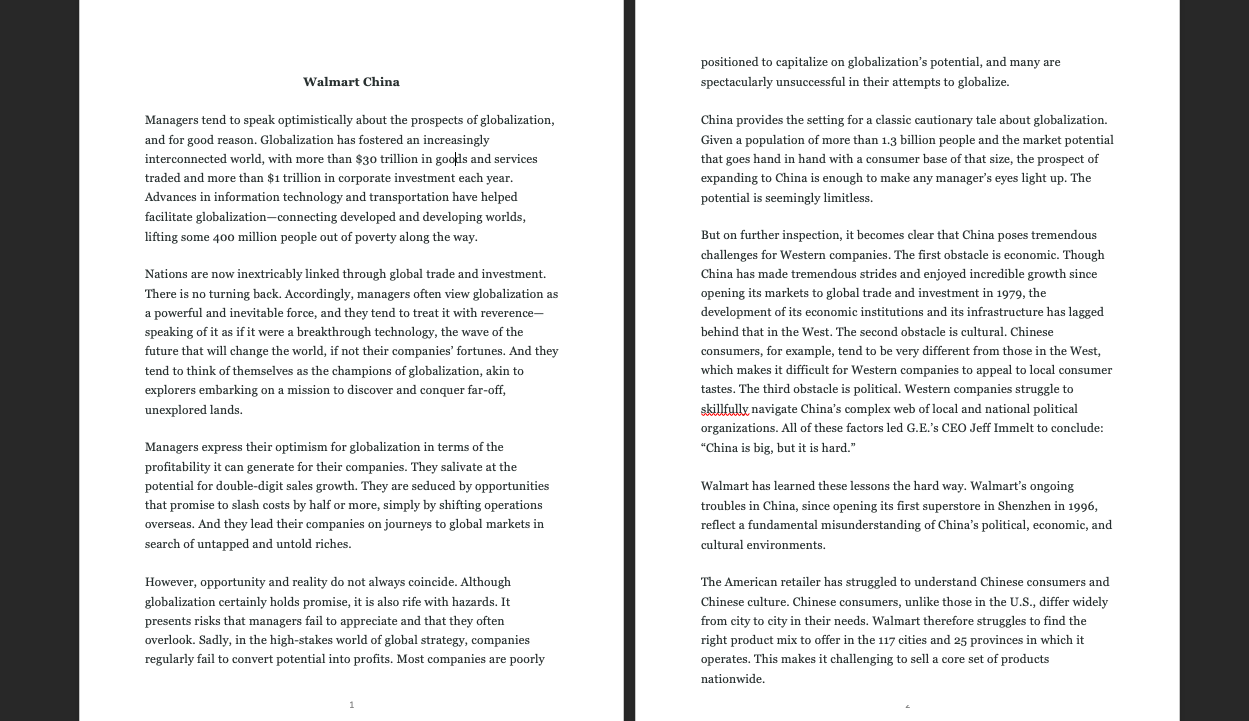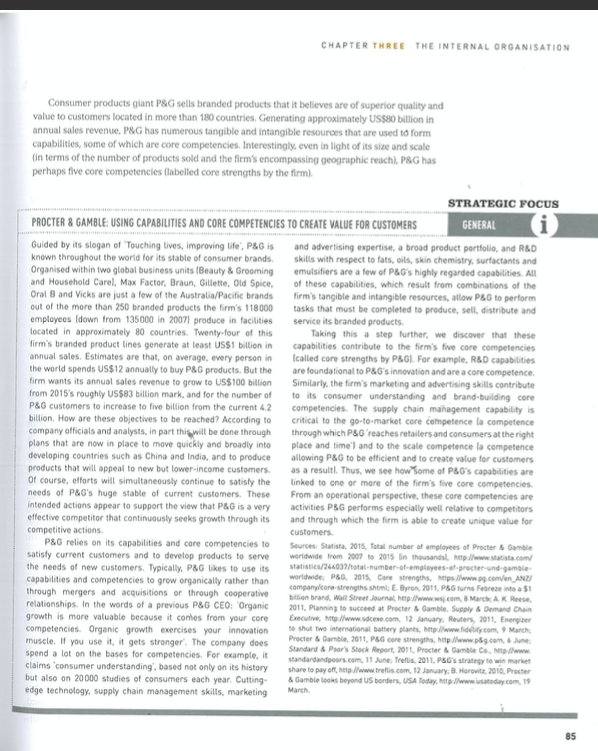Week 8 - Walmart China
Q3. Identify the challenges Walmart need to overcome affecting their implementation of international strategy
Week 10 - Procter and Gamble (P&G)
Q3. Describe how effective corporate governance seeks to ensure ethical decision making by a firm's top-level managers.
positioned to capitalize on globalization's potential, and many are Walmart China spectacularly unsuccessful in their attempts to globalize. Managers tend to speak optimistically about the prospects of globalization, China provides the setting for a classic cautionary tale about globalization. and for good reason. Globalization has fostered an increasingly Given a population of more than 1.3 billion people and the market potential interconnected world, with more than $30 trillion in goods and services that goes hand in hand with a consumer base of that size, the prospect of traded and more than $1 trillion in corporate investment each year. expanding to China is enough to make any manager's eyes light up. The Advances in information technology and transportation have helped potential is seemingly limitless. facilitate globalization-connecting developed and developing worlds, lifting some 400 million people out of poverty along the way. But on further inspection, it becomes clear that China poses tremendous challenges for Western companies. The first obstacle is economic. Though Nations are now inextricably linked through global trade and investment. China has made tremendous strides and enjoyed incredible growth since There is no turning back. Accordingly, managers often view globalization as opening its markets to global trade and investment in 1979, the a powerful and inevitable force, and they tend to treat it with reverence- development of its economic institutions and its infrastructure has lagged speaking of it as if it were a breakthrough technology, the wave of the behind that in the West. The second obstacle is cultural. Chinese future that will change the world, if not their companies' fortunes. And they consumers, for example, tend to be very different from those in the West, tend to think of themselves as the champions of globalization, akin to which makes it difficult for Western companies to appeal to local consumer explorers embarking on a mission to discover and conquer far-off, tastes. The third obstacle is political. Western companies struggle to unexplored lands. skillfully navigate China's complex web of local and national political organizations. All of these factors led G.E.'s CEO Jeff Immelt to conclude: Managers express their optimism for globalization in terms of the "China is big, but it is hard." profitability it can generate for their companies. They salivate at the potential for double-digit sales growth. They are seduced by opportunities Walmart has learned these lessons the hard way. Walmart's ongoing that promise to slash costs by half or more, simply by shifting operations troubles in China, since opening its first superstore in Shenzhen in 1996, overseas. And they lead their companies on journeys to global markets in reflect a fundamental misunderstanding of China's political, economic, and search of untapped and untold riches. cultural environments. However, opportunity and reality do not always coincide. Although The American retailer has struggled to understand Chinese consumers and globalization certainly holds promise, it is also rife with hazards. It Chinese culture. Chinese consumers, unlike those in the U.S., differ widely presents risks that managers fail to appreciate and that they often from city to city in their needs. Walmart therefore struggles to find the overlook. Sadly, in the high-stakes world of global strategy, companies right product mix to offer in the 117 cities and 25 provinces in which it regularly fail to convert potential into profits. Most companies are poorly operates. This makes it challenging to sell a core set of products nationwide.Walmart has also suffered from troubled relationships with politicians- borne out of cross-country differences can overwhelm even the best-laid both local and national. The company has had its fair share of run-ins with globalization plans. And Walmart is no exception. the law. On one occasion the Chinese government fined Walmart for violating local and national laws and even forced it to close stores To improve the practice of global business and to make better global temporarily for purported product violations. Walmart paid the fines, even expansion decisions, managers need a more sophisticated understanding of though the company believed the claims to be unfounded. the economic, political, and cultural environments in the countries in which they intend to operate. They must appreciate how nations differ Although China has led the gobe in infrastructure investment over the last economically, politically, and culturally, and how those differences several years, outside of its largest cities (e.g., Shanghai, Beijing, Tianjin, manifest as increasing risks (and costs). They then need to incorporate Guangzhou, and Shenzhen), its infrastructure remains more than those risks into their existing strategy and financial decision models. problematic. The efficient transport of goods from one region to another is a challenge because of China's sheer physical size, and because its air, Robert Salomon is a professor of International Management and Faculty ground, and rail infrastructure does not meet developed country standards. Scholar at NYU's Stern School of Business and has researched Not surprisingly, Walmart's China business has struggled to generate globalization and global strategy for nearly 20 years. This article is profits, and it has consistently underperformed in this huge and potentially excerpted from his book, Global Vision: How Companies Can Overcome the lucrative market. Pitfalls of Globalization. Published by Palgrave Macmillan; reproduced by permission. The lesson in all of this is that, when it comes to globalization, managers are not just optimists; all too often, they are unbridled optimists. They habitually overestimate the benefits of globalization and underestimate its costs. In evaluating globalization opportunities, managers often forget the other side of the opportunity equation: risk. Risk goes hand in hand with opportunity, and managers fail to accurately account for the risks they face in global markets. Managers often make dangerous assumptions about what it takes to succeed in global markets. They tend to assume that their current business model, one they successfully and profitably exploit in their home country, will translate simply and effectively to other countries, yielding similar levels of profitability. These same managers fail to account for real and salient differences between nations, and fail to consider how those differences generate operational risks that may negatively impact their business. Unfortunately, they end up learning the hard way that the riskCHAPTER THREE THE INTERNAL ORGANISATION Consumer products giant P&G sells branded products that it believes are of superior quality and value to customers located in more than 180 countries. Generating approximately US$80 billion in annual sales revenue, P&G has numerous tangible and intangible resources that are used to form capabilities, some of which are core competencies. Interestingly, even in light of its size and scale (in terms of the number of products sold and the firm's encompassing geographic reach), P&G has perhaps five core competencies (labelled core strengths by the firm). STRATEGIC FOCUS PROCTER & GAMBLE: USING CAPABILITIES AND CORE COMPETENCIES TO CREATE VALUE FOR CUSTOMERS GENERAL i Guided by its slogan of "Touching lives, improving life', P&G is and advertising expertise, a broad product portfolio, and R&D known throughout the world for its stable of consumer brands. skills with respect to fats, oils, skin chemistry. surfactants and Organised within two global business units (Beauty & Grooming emulsifiers are a few of P&G's highly regarded capabilities. All and Household Carel, Max Factor, Braun, Gillette, Old Spice. of these capabilities, which result from combinations of the Oral B and Vicks are just a few of the Australia/Pacific brands firm's tangible and intangible resources, allow P&G to perform out of the more than 250 branded products the firm's 118000 tasks that must be completed to produce, sell, distribute and employees [down from 135000 in 2007] produce in facilities service its branded products. ocated in approximately 80 countries. Twenty-four of this Taking this a step further, we discover that these firm's branded product lines generate at least US$1 billion in capabilities contribute to the firm's five core competencies annual sales. Estimates are that, on average. every person in Icalled core strengths by P&G). For example, R&D capabilities the world spends US$12 annually to buy PAG products. But the are foundational to P&G's innovation and are a core competence. firm wants its annual sales revenue to grow to US$100 billion Similarly, the firm's marketing and advertising skills contribute from 2015's roughly US$83 billion mark, and for the number of to its consumer understanding and brand-building core P&G customers to increase to five billion from the current 4.2 competencies. The supply chain management capability is billion. How are these objectives to be reached? According to critical to the go-to-market core competence la competence company officials and analysts. in part this will be done through through which P& G'reaches retailers and consumers at the right plans that are now in place to move quickly and broadly into place and time'l and to the scale competence la competence developing countries such as China and India, and to produce allowing P&G to be efficient and to create value for customers products that will appeal to new but lower-income customers. as a resultl. Thus, we see how some of P&G's capabilities are Of course, efforts will simultaneously continue to satisfy the linked to one or more of the firm's five core competencies. needs of P&G's huge stable of current customers. These From an operational perspective, these core competencies are intended actions appear to support the view that P&G is a very activities P&G performs especially well relative to competitors effective competitor that continuously seeks growth through its and through which the firm is able to create unique value for competitive actions. customers. P&G relies on its capabilities and core competencies to Sources: Statista, 2015, Total number of employees of Procter & Gamble satisfy current customers and to develop products to serve worldwide from 2007 to 2013 In thousandal, betp //www.statins.com/ the needs of new customers. Typically, P&G likes to use its statistics/244037/total-number.of.employees.of-procter-und-gamble- capabilities and competencies to grow organically rather than worldwide, PSG. 2015, Core strengths. Mtips://wwwpg.com/en_ANZ/ through mergers and acquisitions or through cooperative company/core.strengths shiml; E. Byron, 2011, P&G turns Febreze into a S relationships. In the words of a previous P&G CEO: "Organic tillion brand. Wall Street Journal, http://www.wij.com. 8 March A. K. Reese. 2011. Planning to succeed at Procter & Gamble. Supply & Demand Chain growth is more valuable because it comes from your core Executive, Mip W/www.scene.com, 12 January. Reuters, 2011, Energizer competencies. Organic growth exercises your innovation to shut two international battery planes, betp /www.fiddfurycom, # Marchy muscle. If you use it. it gets stronger. The company does Procter & Gamble, 2011, P&G core strengths, http://www.p&g.com, & June spend a lot on the bases for competencies. For example. it Standard & Poor's Stock Report, 2011, Procter & Gamble Co. http:/www. claims "consumer understanding'. based not only on its history standardandpoors.comm. I1 June: Trellis. 2011, PSG's strategy to win market but also on 20000 studies of consumers each year. Cutting- share to pay off, help //www.treflis.com, 12 January: B. Horowitz, 2010, Procter & Gamble looks beyond US borders, USA Today, Http //wwwismtoday.com, 19 edge technology, supply chain management skills, marketing March. 85









